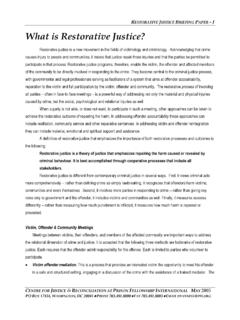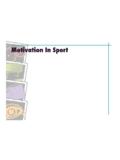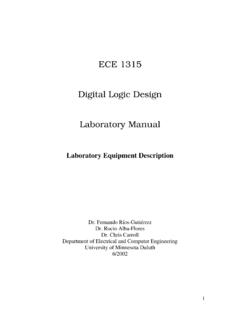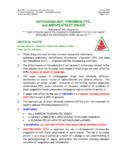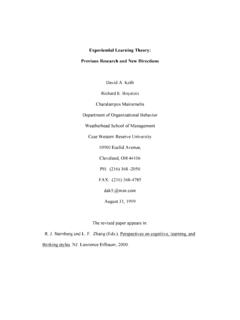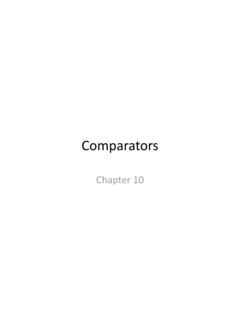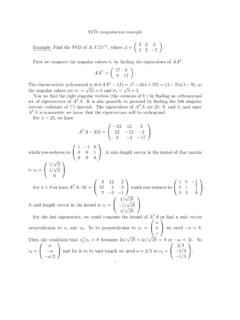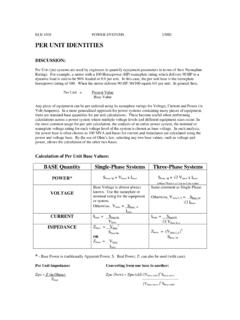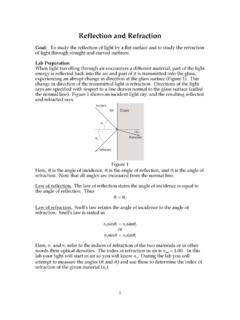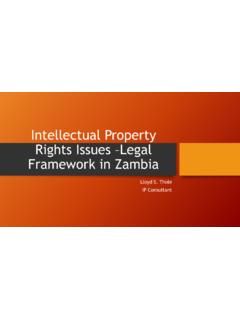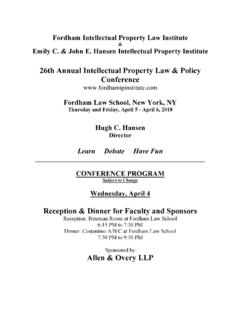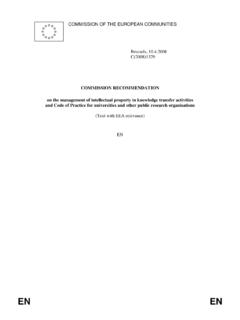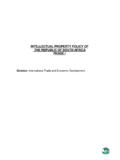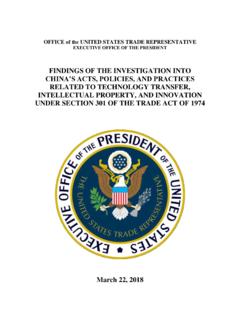Transcription of Whoowns Theimpactof intellectual propertyrightson ...
1 Who owns scientific data? The impact of intellectual property rights on the scientific publication chain 91. Learned Publishing (2005)18, 91 94. Who owns scientific data? I. ntroduction The concept of intellectual property rights (IPRs), which in the academic and research context are mainly con- cerned with patents and copyrights, has broadly speaking served society well. Such The impact of rights stimulate innovation by protecting creative work and investment and by encouraging the ordered exploitation of intellectual scientific discoveries for the good of society. In general they seek to maximize the public good by protecting monopoly rights for a finite period to allow adequate reward for property rights on initiators, while ensuring that the benefits pass eventually into the public domain. But although IPRs can aid the conversion of good science into tangible benefits, the fact the scientific that they are monopolies can cause a ten- sion between private profit and public good.
2 If the balance between these is not correctly set, IPRs can hinder the free exchange of publication chain ideas and information on which science thrives. There is strong evidence that this Roger Elliott balance has shifted in recent years due to University of Oxford social and economic pressures on the one hand and to changes in technologies on the Sir Roger Elliott 2005. other, in ways that threaten the well-being ABSTRACT: intellectual property rights have of the scientific enterprise. become increasingly important in scientific The importance of IPRs has increasingly research. As the legal regime has been tightened impinged on the academic community in and attitudes of funders, employers and researchers recent years for a number of reasons. A. have changed, serious challenges are emerging to greater emphasis on wealth creation, even in the free flow of ideas and information on which academic research, has distorted the old the scientific enterprise rests.
3 It is important that norms of academic behaviour so that every- individual scientists are aware of their rights and one is now encouraged to consider the convinced to use them in the public good. potential financial rewards which may be derived from their work. This pressure can come from the funding agencies because governments seek immediate returns, from universities and other employers who are encouraged to look for funding outside the traditional state grants, and the academics themselves who are tempted by monetary rewards beyond those derived from profes- sional recognition. The focus on research Sir Roger Elliott LEARNED PUBLISHING VOL. 18 NO. 2 APRIL 2005. 92 R. Elliot which leads directly to IPRs is likely to been eroded. Although some steps are now damage the health of science in the longer being taken to correct these anomalies, term. Moreover evidence shows that, while there is strong evidence that some research there are a few big wins, most academic where there is a clear public interest has institutions draw little financial benefit from been inhibited by the IPR discussion.
4 The exploitation of IPRs. These issues have There are also difficulties which arise been broadly addressed by the Royal Society because of the different nature of patent in a report called Keeping Science Open: legislation in different jurisdictions. There The Effects of intellectual property Policy are particular difficulties in Europe because on the Conduct of Science' which can be the many national jurisdictions have not yet found at their website ( ). been fully harmonized on this issue. There As a result there is an increasing per- are also significant differences between ception in some quarters, derived from the Europe, which uses a first to file' system idea of the knowledge society' and knowledge under which any prior disclosure, by economy' that information such as scientific publication or lecture, can negate the claim;. some research facts should be regarded as a commodity and on the other hand the US first to where there is with monetary value.
5 This runs counter invent' system which allows a period of a clear public to the traditional argument that publicly grace during which prior disclosure is interest has funded research, particularly in universities, allowed. Thus the European system must should be driven by the general spirit of clearly delay publication of relevant material been inhibited enquiry, and based on the merit of the work to the detriment of related research. There by the IPR from the point of view of science, rather is support on both sides of the Atlantic for a discussion than its potential for short-term exploitation. system that would combine a grace period If IPRs exist in the scientific information with the clarity of the first to file' procedure which results from research, then serious but such negotiations will take time. questions arise as to who owns them. The legal framework governing IPRs has been strengthened in recent years in a number of ways, usually by strengthening monopoly Copyright rights , by restriction of exceptions, in Copyright grants exclusive rights to creators the face of perceived threats to the rights of original literary, scientific and artistic holders from new technologies.
6 Works with extensions to computer programs In this paper the difficulties that arise in and databases. It protects the form of the the three areas of patents, copyrights and expression of ideas, but not the idea, infor- databases will be briefly considered. mation or concept expressed. The established paradigm, codified in the Berne Convention, has worked well for a century for the written and printed word but changes in technology Patents have given rise to increasing tensions in There has been a creeping tendency in recent recent years. The relative ease of electronic years towards pushing the boundaries of storage and transmission has made copying patents across that ill-defined line between and dissemination easy and cheap, and in so discovery and invention. The three major doing has threatened the economic returns requirements of novelty, inventive step or to the author and the publisher.
7 The reac- non-obviousness, and utility remain, but tion has been to tighten copyright laws in a they have been applied less rigorously in number of ways which have had significant many jurisdictions. There is, for example, a consequences, not all of them intended, on real question whether scientific facts such as the academic and scientific sectors. a DNA genome sequence meet such criteria Copyright always initially resides with the particularly when the utility in practical author unless it is overridden by the con- terms is ill-defined and distant. Moreover, tract of employment. In the academic world the exceptions for private and non- universities have traditionally either explicitly commercial' and experimental' use have or implicitly waived any rights they might LEARNED PUBLISHING VOL. 18 NO. 2 APRIL 2005. Who owns scientific data? The impact of intellectual property rights on the scientific publication chain 93.
8 Have, leaving these for articles, monographs Databases and textbooks with the academics them- Databases, collections of data organized in a selves. With the advent of distance learning systematic way, play an important role in there is a potential conflict of interest in scientific research. While they were tradition- teaching material which clearly derives from ally found in books such as encyclopaedias, employment. digitization and the potential for low-cost A much larger area of conflict has global communication has opened up tre- developed in the treatment of scientific mendous opportunities for their dissemination information. and use. While the common-law tradition of The traditional vehicle for transmission of the US and the UK gave copyright pro- the results of research is through learned tection for such work through the sweat of journals where the established pattern has the brow' investment, providing a certain been for the publisher to require transferral level of creativity was met, in most contin- of copyright in exchange for the value added ental European jurisdictions the concept of through quality control and distribution of droit d'auteur required a higher level of the printed material.
9 Creativity than many compilations enjoyed the scientific This has been accepted by scientists in the and thus the EU has introduced a new sui past since they seek only the widest possible community generis right to extend a protection similar to dissemination of their material and ideas copyright for databases. However, with the should strive to and do not expect direct monetary reward, commercial sector in mind (court cases to keep key which comes through career enhancement. Some publishers have in recent years driven date have been concerned with lists of things databases like horse race runners, real estate property a hard bargain and taken what have appeared and market prices), the legislation was within the to be excessive profits for providing this drawn tightly in a way that is very inimical public domain service. With the almost universal accept- to science and its traditional method of ance of electronic publishing for this material working.
10 In the first place the law gives a debate has arisen as to whether the author protection to the data themselves (which is and user community, which are in fact the not covered by copyright) and forbids their same, might not take back control of this extraction and reuse without permission of chain with more limited intervention by the rights holder. Moreover that person is publishers and librarians. Several alternative the creator of the database and not the models, such as the Open Access Initiative, creator of the data themselves; a procedure discussed elsewhere, are now being con- that in science is infinitely more expensive sidered. than creating the database. Thus the law has The situation is exacerbated from the a potential for preventing easy access to scientists' point of view by a tightening of expensive data without payment to a self- the laws relating to fair use', certainly in appointed gatekeeper.
